Chiaroscuro. Emilio Gallego's Sculptural Works
|
Chiaroscuro
Emilio Gallego's Sculptural
Works
From June 30th to
October to 2nd 2005
Sala Oberta - La Nau
From
Tuesday to Saturday, from 10 to 13.30 and from 16 to 20 h.
Sunday, from 10 to 14 h.
|
|
|
|
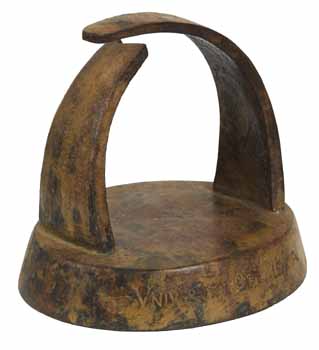 |
|
|
|
Commissioned by Valencia University, this project seeks
to create a representative icon in the form of a bronze
sculpture to reflect the meaning of the educational
institution in the world of knowledge and Valencian
culture during the past 500 years, a period during which
the university catalysed and drove the development of a
modern competitive society. The sculpture will help
recognise the cooperation of those members of society
and the university community who have somehow
facilitated and supported the remarkable role played by
Universitat.
The astronomic observatory on the roof of the university
head office -built in the early 20th century
by the professor in cosmography and physics of the globe
Ignasi Tarazona- has been used as a plastic and symbolic
referent for the development of the project.
Formally, it consists of two triangular solid pieces
that rotate over an elliptical basis, crossing each
other with no contact; one of them seems to break on the
vertex, this alluding to classical culture statuary.
Thus, the sculpture shapes a figure into a central void
that reminds us of the university observatory and
includes interesting symbols connected with it as an
instrument for the knowledge of the universe and through
its relationship with the institution that actually
shelters it. Likewise, Chiaroscuro suggests a
threshold idea, an open gate to a an open field of
culture and progress. The evident ‘open’ nature of this
free but protected ‘new-space seeker’ structure
represents in a simple but categorical way the longing
for conservation and human knowledge. At the same time
its openness reflects the democratic principles required
by such tasks to evolve in today's society, evidencing
the need for conservation, transmission, creation and
research values represented by university in the realms
of culture, sciences, and arts. Chiaroscuro aims
to become a symbol of the whole university community as
a way to reward their commitment and efforts in
improving the quality of their work and in developing a
better world.
Emilio Gallego. Requena, June 2005 |
|
|
|
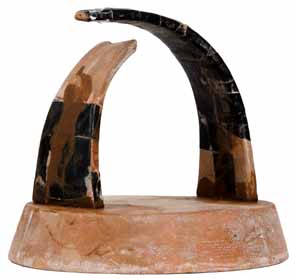 |
 |
|
|
|
ABOUT EMILIO GALLEGO AND HIS “CHIAROSCURO”
Everybody seems to understand we are settled down in a
fragmentary, paradoxical, uncertain and trivial world
made up of worlds. That social and cultural “reality”
–with which contemporary philosophic approaches seem to
agree- does not relieve us of the collective efforts
needed in asserting and sustaining the axiology that
vertebrates the historic times we live in. In this
respect, it is well-known that the contribution of
plastic artists (either through “descriptions",
“interpretations” or creative “proposals”) is frequently
distinctive so as to clarifying aspects in our present,
and sometimes nodal in perceiving horizons that will
“draw” the “landscape” of tomorrow’s new "reality".
These are a few ‘cramped’ reflections on Emilio
Gallego's sculpture. I followed the evolution of his
plastic skills with great interest –after he settled
down in Requena, Valencia- and saw how his artistic
personality came together displaying “atmospheres” and
distilling “sensitivities”. His artistic ‘melting pot’
includes certainties and contradictions, convictions and
irony, ideas filtered by reason and fantasies born from
subjectivity… The author of murals, sculptures and
interventions, he plays with stone, wood, and steel to
create figures with strong rural echoes and an intense
energetic and animist presence. Multiple meanings can be
drawn from his works: representations of natural growth,
the story of life, the four elements or the cardinal
points, the vegetal and mineral world... But they are
also representations of farming implements or grain
mills. Emilio Gallego (in his individual and collective
exhibitions and his public sculptures in different
places in his region, like totems) finds his inspiration
in nature’s energy and the expansive need of green
awareness. Nature itself, through erosion, oxidation,
scraping or scratching, transforms and decants his works
welcoming them into its own geological cycle.
The exhibition –Chiaroscuro- illustrates the author’s
artistic understanding, swinging from objectualism to
installationism. Obviously, the objects -
tridimensionally "manufactured"- transcend their
implicit aesthetic value, as they are devised for
"intervention" in a given space and since the sculptor's
aim is to "create atmospheres" shaping open-air
signification and communication fields. As Heidegger
would put it, the artist replaces the “site” chosen for
an artistic object by the creation of a “place”
presumably assigned with a symbolic role. In providing
the context with an "active value", the artist (a
producer of images) can transform, falsify, underline,
simulate, introduce integrations, cause dissonance,
stress contrast. |
|
|
|
 |
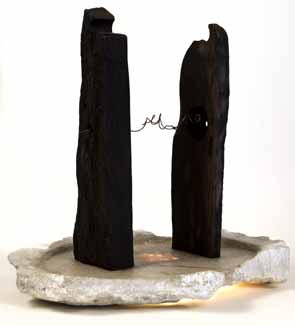 |
|
|
|
Formally and stylistically, his central piece –
“Chiaroscuro” (forged in metal during modernity) falls
within the context of canonical sculpture and its
pluriform lines. Based on an innovative concept
(considering empty spaces as sculptural materials),
relevant artists from the second half of the 20th
century sealed their respective poetics from their own
very personal languages and approaches: Anthony Caro,
Jorge Oteiza, Eduardo Chillida, Andreu Alfaro in the
1950s, Martín Chirino, Richard Deacon, Richard Serra… As
the author himself says, “it is made from two solid
triangles which –from an elliptical base- rotate until
they cross each other without contact”. In their empty
inside, Emilio Gallego tries to draw something that
evokes the old observatory at the headquarters of
Valencia University. The symbolic referentiality of this
art piece required a lot of thinking from the artist,
who was most keen on developing the project: “The
evident open-air nature of this protected ‘new-spaces
seeker’ structure represents in a simple but categorical
way the longing for conservation and human knowledge. At
the same time its openness reflects the democratic
principles required by such tasks to evolve in today's
society, evidencing the need for conservation,
transmission, creation and research values represented
by university in the realms of culture, sciences, and
arts".
Juan Ángel Blasco Carrascosa.
Professor of History of Art. Valencia
Polytechnic University |
|
|
|
 |
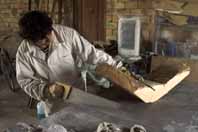 |
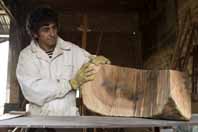 |
|
|
|
|